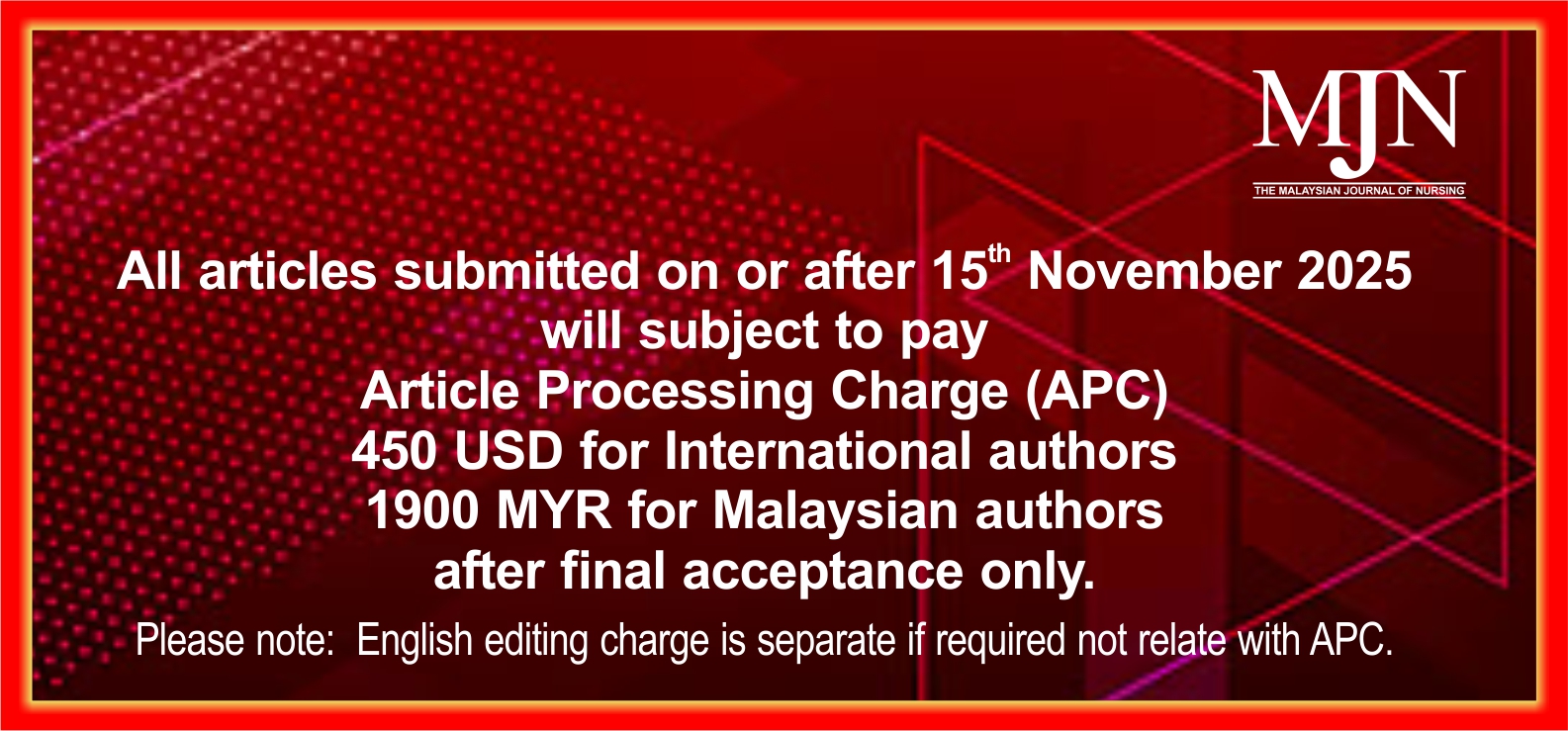Effect of Hypno-Pressure on Mean Arterial Pressure in Patients with Cardiovascular Disorders
DOI:
https://doi.org/10.31674/mjn.2023.v14i03.010Abstract
Background: The mean arterial pressure (MAP) is the average arterial pressure during one cardiac cycle (systole, and diastole). MAP is affected by cardiac output and systemic vascular resistance, each of which is affected by several factors.
Objective: This aim of this study is to determine the effectiveness of hypno-pressure on Mean Arterial Pressure (MAP) in patients with cardiovascular disorders.
Methods: A quasi-experimental research design with a pretest-posttest with a control group was used in this study. Purposive sampling was used to select 56 respondents for this study, and twenty-eight respondents were randomly assigned to the experiment and control groups. The bedside monitor was used to measure MAP. Paired t-tests and Independent t-tests were used for data analysis.
Results: There was a significant effect of hypno-pressure on the decrease of MAP value in patients with cardiovascular disorder with p-value 0.000 (<0.05), t = 7.217, and effect size of 1.18.
Conclusion: Hypno-pressure could reduce MAP in patients with cardiovascular disorders.
Keywords:
MAP, Cardiovascular Disorders, Hypnosis, AcupressureDownloads
References
Aaronson, P., Ward, J., & Connolly , M. (2012). The Cardiovascular System at a Glance, 4th Edition. London.
Aris, S. (2011). Statistik untuk Penelitian Kesehatan 1. Cetakan1. Yogyakarta: Nuha Medika.
Bahall, M. (2015). Complementary and alternative medicine usage among cardiac patients: A descriptive study. BMC Complementary and Alternative Medicine, 1-8. https://doi.org/10.15171/ijhpm.2015.88
Florea, V. G., & Cohn, J. N. (2014). The Autonomic Nervous System and Heart Failure. Journal Circulation Research, 11(14),1815-1826. https://doi.org/10.1161/CIRCRESAHA.114.302589
Frazier, S. K., Moser, D. K., Daley, L. K., McKinley, S., Riegel, B., Garvin, B. J., & An, K. (2003). Critical Care Nurses’ Beliefs About and Reported Management of Anxiety. American Journal of Critical Care, 12(1) 19–27. https://doi.org/10.4037/ajcc2003.12.1.19
Ghorpade, A. G., Shrivastava, S. R., Kar, S. S., Sarkar, S. , Majgi, S. M., & Roy, G. (2015). Estimation of the cardiovascular risk using World Health Organization/International Society of Hypertension (WHO/ISH) risk prediction charts in a rural population of South India. International Journal of Health Policy and Management, 4(8), 531–536.
Grant, S. J., Bin, Y. S., Kiat, H., & Chang, D. H. (2012). The use of complementary and alternative medicine by people with cardiovascular disease: a systematic review. BMC Public Health, 12, 299. https://doi.org/10.1186/1471-2458-12-299
Kadir, A. (2010). Perubahan Hormon terhadap Stress. Jurnal Ilmiah Kedokteran Wijaya Kusuma, 2(1), 88-97.
Kubzansky, L. D., Huffman, J. C., Boehm, J. K., Hernandez, R., Kim, E. S., Koga, H. K., ... & Labarthe, D. R. (2018). Positive psychological well-being and cardiovascular disease: JACC health promotion series. Journal of the American College of Cardiology, 72(12), 1382-1396.
Kuo, S. Y., Tsai, S. H., Chen, S. L., & Tzeng, Y. L. (2016). Auricular acupressure relieves anxiety and fatigue, and reduces cortisol levels in post-caesarean section women: A single-blind, randomised controlled study. International Journal of Nursing Studies, 53, 17-26. https://doi.org/10.1016/j.ijnurstu.2015.10.006
Maendra, I. K., Munayang, H., Dundu, A. E., & Ekawardani, N. (2014). Prevalensi Tingkat Kecemasan Pada Pasien Infark Miokard Lama di Poliklinik Jantung RSUP Prof . Dr. R.D. Kandau. Jurnal e-Clinic, 2(3). https://doi.org/10.35790/ecl.v2i3.6342
Mittleman, M. A., Taylor, W. C., Smetana, G., & Burns, R. B. (2015). Treatment of blood cholesterol to reduce risk for atherosclerotic cardiovascular disease: grand rounds discussion from the beth Israel Deaconess Medical Center. Annals of Internal Medicine, 163(4), 280-290. https://doi.org/10.7326/M15-1125
Moyo, P., Huang, T. Y., Simoni-Wastila, L., & Harrington, D. (2018). Exploratory and Confirmatory Factor Analyses of Delirium Symptoms in a Sample of Nursing Home Residents. Journal of Applied Gerentology, 37(2),228-255. https://doi.org/10.1177/0733464816633859
Nguyen, H. N., Fujiyoshi, A., Abbott, R. D., & Miura, K. (2013). Epidemiology of Cardiovascular Risk Factors in Asian Countries. Circulation Journal, CJ-13. https://doi.org/10.1253/circj.CJ-13-1292
Nowbar, A. N., Howard, J. P., Finegold, J. A., Asaria, P., & Francis, D. P. (2014). 2014 global geographic analysis of mortality from ischaemic heart disease by country, age and income: statistics from World Health Organisation and United Nations. International Journal of Cardiology, 174(2), 293-298. https://doi.org/10.1016/j.ijcard.2014.04.096
Nurarif, A. H., & Kusuma, H. (2015). Aplikasi asuhan keperawatan berdasarkan diagnosa medis & NANDA.
Prasetyaningsih, Y. A. (2010). Tinjauan Interaksi Obat pada Pasien Gagal Jantung Kongestif di Instalasi Rawat Inap Rumah Sakit Umum Daerah Pandan Arang Kabupaten Boyolali. eprints ums.ac.id, 1-23.
Riskesdas, T. (2019). Laporan nasional RISKESDAS 2018. Jakarta: Badan Penelitian dan Pengembangan Kesehatan.
Salim, A. W. (2015). Fibrilasi Atrium sebagai Faktor Risiko Kejadian Stroke Non Hemoragik di Bagian Saraf RSUD Dr Soedarso Pontianak. Jurnal Mahasiswa PSPD FK Universitas Tanjungpura, 3(1).
Sanjaka, A. (2015). Aplikasi SPSS Untuk Analisis Data Penelitian Kesehatan. Yogyakarta: Nuha Medika.
Sanjoyo, R. (2006). Obat (Biomedik Farmakologi). Yogyakarta: D3 Rekam Medis FMIPA Universitas Gadjah Mada .
Siswanto, B. B., Hersunarti, N., Erwinanto, B. R., Pratikto, R. S., Nauli, S. E., & Lubis, A. C. (2015). Pedoman Tatalaksana Gagal Jantung. Indonesia Heart Association, 1.
Sugiyono (2016). Memahami Penelitia Kuantitatif. Bandung: CV Alfabeta.
Tseng, C. C., Tseng, A., Lin, J. G., & Chang, H. H. (2015). The Effect of Acupuncture at Ear Shenmen on Heart Rate Variability: A Subject-Assessor-Blinded Randomized, Sham-Controlled Crossover Study. Chinese Medical Journal, 26(2), c1-8. https://doi.org/10.3966/241139642015122602003
Tully, P. J., Cosh, S. M., & Baune, B. T. (2013). A review of the affects of worry and generalized anxiety disorder upon cardiovascular health and coronary heart disease. Psycholo
Published
How to Cite
Issue
Section
License
Copyright (c) 2022 The Malaysian Journal of Nursing (MJN)

This work is licensed under a Creative Commons Attribution-NonCommercial-NoDerivatives 4.0 International License.



































